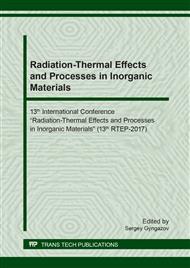[1]
Thin-Film Deposition: Principles and Practice, McGraw Hill, Boston, 1995. ISBN-13: 978-0070585027.
Google Scholar
[2]
D.G. Piliptsou, A.S. Rudenkov, A.V. Rogachev, J. Xiaohong, P.A. Lychnikov, V.A. Emel'yanov, XPS study of the structure of nitrogen doped a-C film, IOP Conference Series: Materials Science and Engineering 168(1) (2017) 012103.
DOI: 10.1088/1757-899x/168/1/012103
Google Scholar
[3]
P.А. Luchnikov, O.A. Surzhikova, Process of Formation of Vacuum Polymer Films in the HF Discharge Reactor, IOP Conference Series: Materials Science and Engineering 189 (2017) 012014.
DOI: 10.1088/1757-899x/189/1/012014
Google Scholar
[4]
G. Bräuer, B. Szyszka, M. Vergöhl, R. Bandorf, Magnetron sputtering - Milestones of 30 years, Vacuum 84(12) (2010) 1354-1359.
DOI: 10.1016/j.vacuum.2009.12.014
Google Scholar
[5]
G.A. Bleykher, A.V. Yuryeva, A.S. Shabunin, V.P. Krivobokov, D.V. Sidelev, The role of thermal processes and target evaporation in formation of self-sputtering mode for copper magnetron sputtering, Vacuum152 (2018) 156-165.
DOI: 10.1016/j.vacuum.2018.03.020
Google Scholar
[6]
J. Musil, V.Satava, P. Baroch, High-rate reactive deposition of transparent SiO2 films containing low amount of Zr from molten magnetron target, Thin Solid Films 519 (2010) 775-777.
DOI: 10.1016/j.tsf.2010.09.009
Google Scholar
[7]
M. Laurikaitis, J.C. Yviene, J. Dudonis, Deposition of Zr–ZrOx and Y–YxOy films by reactive magnetron sputtering, Vacuum 78 (2005) 395-399.
DOI: 10.1016/j.vacuum.2005.01.056
Google Scholar
[8]
A.V. Tumarkin, A.V. Kaziev, D.V. Kolodko, A.A. Pisarev, M.M. Kharkov, G.V. Khodachenko, Deposition of copper coatings in a magnetron with liquid target, Phys. Atom. Nucl. 78 (2015) 1674-1676.
DOI: 10.1134/s1063778815140136
Google Scholar
[9]
A.V. Yuryeva, A.S. Shabunin, D.V. Korzhenko, O.S. Korneva, M.V. Nikolaev, Effect of material of the crucible on operation of magnetron sputtering system with liquid-phase target, Vacuum 141 (2017) 135-138.
DOI: 10.1016/j.vacuum.2017.04.001
Google Scholar
[10]
P.A. Luchnikov, V.V. Vetrova, N.P. Zubkov, O.A. Surzhikova, N.I. Chernova, Deformable Polymer Dielectric Films in Phase Light Modulators, IOP Conference Series: Materials Science and Engineering 189 (2017) 012027.
DOI: 10.1088/1757-899x/189/1/012027
Google Scholar


